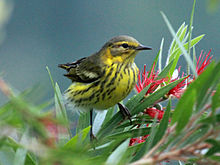Spectacular birding in Quebec, but Nova Scotia also has lots to attract birders as well as birds with or without a budworm outbreak!

Cape May warbler
(Wikipedia)
View A River of Warblers: ‘The Greatest Birding Day of My Life’ By James Gorman The New York Times, May 31, 2018.
From the article:
The reason for the large number, Mr. Davies speculated, was that these are birds that eat the larvae of the spruce budworm, and their populations explode when the budworm numbers go up.
There were more than 100,000 each of Cape May Warblers, Bay Breasted warblers and Tennessee warblers.
Like the rest of the world, birders use Twitter, and they tweeted in delight:
Have you ever seen 100k Cape May warblers in a day? This person has, and it’s just the beginning of a mind-blowing day: Checklist S46116491 – @USFWS, May 29, 2018
Nova Scotia also has lots to attract birders as well as birds, with or without a budworm outbreak!:
Tadoussac is a fantastic place for bird migration in both spring and fall. To briefly summarize its history, it started out in 1990 as a hawk watching station which was enormously successful. Then they tried their hand at attracting and banding Northern Saw-whet Owls, Boreal Owls and song birds and were enormously successful. They moved from there to researching Black-backed Woodpeckers and Three-toed Woodpeckers and were enormously successful (you™re getting the picture). Finally they added other boreal species (e.g. Pine Grosbeak) to their efforts. Basically no matter what they have tried it™s been a success.
They benefit from the topography of their location in Saguenay National Park. They are literally set up at the crest of the north shore of the St. Lawrence River. At that point it is very high above the river and migrating birds move along the crest in huge numbers rather than cross the wide expanse of the river.
The effect is not unlike that found at a number of locations in Nova Scotia except the phenomena will be a fall-out in NS rather than a steadily moving stream of birds. It will also involve a smaller amount of birds because in the spring the geography and migration patterns do not work to concentrate birds in the province in the same fashion as they do in the fall. Eric Mills noted such an event on Brier Island earlier. In the fall the numbers of migrating song birds certainly rivals that seen at Tadoussac at many of the province™s locations.- Post by LI on What’s Happening in Birding Today, May 30, 2018
